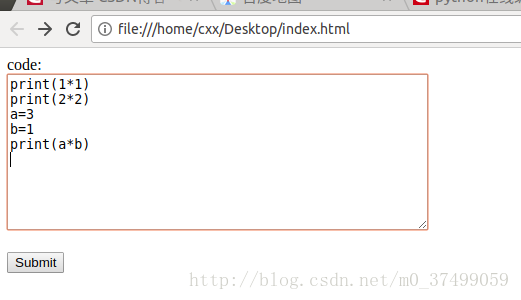python在线编译器 python在线编译器的简单原理及简单实现代码
superboycxx 人气:1想了解python在线编译器的简单原理及简单实现代码的相关内容吗,superboycxx在本文为您仔细讲解python在线编译器的相关知识和一些Code实例,欢迎阅读和指正,我们先划重点:python在线编译器,python,编译器,下面大家一起来学习吧。
我们先来看一下效果(简单的写了一个):



原理:将post请求的代码数据写入了服务器的一个文件,然后用服务器的python编译器执行返回结果
实现代码:
#flaskrun.py
# -*- coding: utf-8 -*-
# __author__="ZJL"
from flask import Flask
from flask import request
from flask import Response
import json
import zxby
app = Flask(__name__)
def Response_headers(content):
resp = Response(content)
resp.headers['Access-Control-Allow-Origin'] = '*'
return resp
@app.route('/')
def hello_world():
return Response_headers('hello world!!!')
@app.route('/run', methods=['POST'])
def run():
if request.method == 'POST' and request.form['code']:
code = request.form['code']
print(code)
jsondata = zxby.main(code)
return Response_headers(str(jsondata))
@app.errorhandler(403)
def page_not_found(error):
content = json.dumps({"error_code": "403"})
resp = Response_headers(content)
return resp
@app.errorhandler(404)
def page_not_found(error):
content = json.dumps({"error_code": "404"})
resp = Response_headers(content)
return resp
@app.errorhandler(400)
def page_not_found(error):
content = json.dumps({"error_code": "400"})
resp = Response_headers(content)
return resp
@app.errorhandler(405)
def page_not_found(error):
content = json.dumps({"error_code": "405"})
resp = Response_headers(content)
return resp
@app.errorhandler(410)
def page_not_found(error):
content = json.dumps({"error_code": "410"})
resp = Response_headers(content)
return resp
@app.errorhandler(500)
def page_not_found(error):
content = json.dumps({"error_code": "500"})
resp = Response_headers(content)
return resp
if __name__ == '__main__':
app.run(debug=True)
#zxby.py
# -*- coding: utf-8 -*-
# __author__="ZJL"
import os, sys, subprocess, tempfile, time
# 创建临时文件夹,返回临时文件夹路径
TempFile = tempfile.mkdtemp(suffix='_test', prefix='python_')
# 文件名
FileNum = int(time.time() * 1000)
# python编译器位置
EXEC = sys.executable
# 获取python版本
def get_version():
v = sys.version_info
version = "python %s.%s" % (v.major, v.minor)
return version
# 获得py文件名
def get_pyname():
global FileNum
return 'test_%d' % FileNum
# 接收代码写入文件
def write_file(pyname, code):
fpath = os.path.join(TempFile, '%s.py' % pyname)
with open(fpath, 'w', encoding='utf-8') as f:
f.write(code)
print('file path: %s' % fpath)
return fpath
# 编码
def decode(s):
try:
return s.decode('utf-8')
except UnicodeDecodeError:
return s.decode('gbk')
# 主执行函数
def main(code):
r = dict()
r["version"] = get_version()
pyname = get_pyname()
fpath = write_file(pyname, code)
try:
# subprocess.check_output 是 父进程等待子进程完成,返回子进程向标准输出的输出结果
# stderr是标准输出的类型
outdata = decode(subprocess.check_output([EXEC, fpath], stderr=subprocess.STDOUT, timeout=5))
except subprocess.CalledProcessError as e:
# e.output是错误信息标准输出
# 错误返回的数据
r["code"] = 'Error'
r["output"] = decode(e.output)
return r
else:
# 成功返回的数据
r['output'] = outdata
r["code"] = "Success"
return r
finally:
# 删除文件(其实不用删除临时文件会自动删除)
try:
os.remove(fpath)
except Exception as e:
exit(1)
if __name__ == '__main__':
code = "print(11);print(22)"
print(main(code))
运行app.run()方法,通过post提交代码,就ok了。我们可以对输出结过做进一步的处理,我这只是为了解一下原理,就没继续了。
加载全部内容